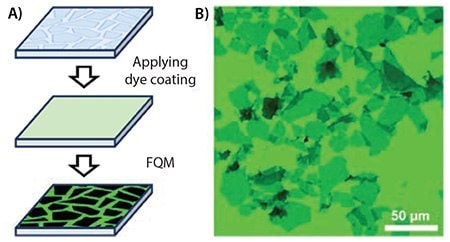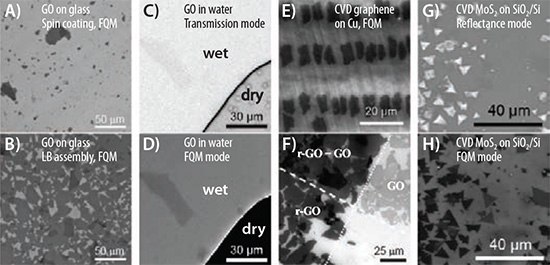Fluorescence Quenching Microscopy
Alane Lim, Jiaxing Huang
Department of Materials Science and Engineering, Northwestern University, Evanston, IL 60208, USA
Introduction
Developed in the last several years, fluorescence quenching microscopy (FQM)1–3 has enabled rapid, inexpensive, and high-fidelity visualization of two-dimensional (2D) materials such as graphene-based sheets (Product No. 763713, 794341 and 777684) and MoS2 (Product No. 234842 and 69860). Graphene and other emerging 2D materials have attracted considerable interest in recent years due to their novel properties and exciting applications,4 but the characterization of these materials has remained challenging. In conventional fluorescence microscopy, imaging is enabled by fluorescent labeling, where excitation makes the targets lighten up against a dark background. However, this approach becomes less effective when the objects of interest are strong fluorescence quenchers, such as graphite and graphene-based sheets.1,5,6 FQM-based techniques use a reverse approach, where a fluorescent layer is applied to cover both the targets and their surrounding area. Upon excitation, graphene-based sheets appear dark against a bright background. The long-range fluorescence quenching capability of 2D materials1–3,5 also makes it possible to differentiate overlapping layers, wrinkles, and folds because they appear darker than single layers. Thus, FQM is capable of producing crisp images with contrast and layer resolution, comparable to those obtained from atomic force microscopy (AFM) and scanning electron microscopy (SEM). A further advantage of FQM is its flexibility in different formats: capable of imaging 2D sheets on arbitrary substrates and in solution.
Basic Principles of Imaging 2D Materials by FQM
Graphene-based sheets quench the fluorescence of dye molecules through either long-range energy transfer mediated by dipole–dipole interactions or short-range electron/charge transfer. The charge transfer mechanism requires orbital overlap, and is, thus, limited within the distance of molecular contact. In contrast, dipole–dipole interactions can extend over much longer distances through empty or even occupied space.7 Although both mechanisms lead to fluorescence quenching, only the long-range mechanism, which is essentially Forster resonance energy transfer (FRET), is suitable for FQM as it enables contrast between different numbers of layers.1–3,8 Signal contrast in an FQM measurement is generated through the difference in fluorescence quenching between the sample of interest and the substrate (which is quite generic to all materials). Since the lateral resolution of FQM is diffraction limited, when performed using a standard optical microscope, FQM is especially wellsuited for imaging objects with micron-scale lateral dimensions such as graphene sheets, graphene oxide, and flakes of other 2D materials.
Methods and Procedures of FQM
FQM samples can be conveniently prepared by spin-coating a dyedoped polymer layer onto a substrate (Figure 1A). A polymer is added to produce a uniform thin film, upon which a fluorescent dye is dispersed to enable imaging. Due to the broadband quenching capability of graphene-based sheets, FQM is not limited by the wavelength of illumination and can be performed using a wide range of fluorescent materials. Therefore, a great number of dye/polymer combinations can be used based on their processability in different solvents, as well as their capability of forming thin films. For example, fluorescein (Product No. 46955)/polyvinylpyrrolidone (Product No. 234257, 856568 and 437190) (FL/PVP) can be processed in water or ethanol, and 4-(dicyanomethylene)-2-methyl-6-(4-dimethylaminostyryl)-4H-pyran (Product No. 410497)/poly(methyl methacrylate) (Product No. 182230, 445746, etc.) (DCM/PMMA) can be processed in organic solvents such as chloroform (Product No. 437581, etc.), toluene (Product No. 179418, etc.), and anisole (Product No. 123226 and 296295). The fluorescent layer can be either on top of the sample or beneath it. The thickness of the dye/polymer layer affects the contrast of FQM images. Dye layer thickness in the range of tens of nanometers has been shown to produce the highest quality FQM images, achieving high contrast and the ability to resolve different numbers of layers. Figure 1B is an FQM image of graphene oxide (GO) sheets deposited on a glass coverslip taken with a digital camera directly through an eyepiece of a fluorescence microscope. This image represents the naked-eye view under FQM. Note that if the substrate itself is fluorescent, one can take advantage of such auto-fluorescence to perform FQM directly without any additional dye layer.

Figure 1.A) FQM can be conveniently performed by applying a dye coating on samples deposited on an arbitrary substrate. B) A naked-eye view of GO sheets on a glass coverslip, obtained with a digital camera directly through an eyepiece of the microscope, showing vivid contrast between different numbers of layers. Wrinkles, folds, and overlaps can be clearly seen. The dye layer was FL/PVP. Reproduced with permission from Reference 1, copyright American Chemical Society.
FQM offers significant advantages over the three most commonly used microscopy methods for imaging 2D materials: reflectance mode of optical microscopy, atomic force microscopy (AFM), and scanning electron microscopy (SEM). All of these techniques are limited to 2D sheets deposited on specific substrates. Reflectance-mode optical microscopy can only produce sufficient contrast using samples deposited on specific types of Si wafers. Meanwhile, AFM is a very low throughput metrology method and can only image small sample areas on molecularly smooth substrates. SEM requires sheets be deposited on conductive substrates and can only be performed under vacuum. In contrast, FQM can tolerate significant surface roughness compared to AFM and reflectance spectroscopy and works on a wide variety of substrates, including metal, glass, and plastic. While previously it has been difficult to image graphene and related 2D materials on glass or plastic substrates, FQM finally allows for rapid microscopy of these 2D sheets using common chemicals and lab supplies.

Figure 2.FQM images of GO sheets (Product No. 763705) deposited on coverslip by (A) spin coating and (B) LB assembly. Optical microscopy images of GO sheets suspended in fluorescein solution acquired by (C) transmission and (D) FQM modes. E) An FQM image showing CVD graphene flakes grown on Cu foil. F) FQM can readily differentiate graphene-based sheets with different degrees of graphitization. Optical microscopy images of CVD grown MoS2 sheets on SiO2/Si substrate acquired by (G) reflectance and (H) FQM modes. The thinnest sheets are more visible in the FQM image. C–D) are reproduced with permission from Reference 1, copyright American Chemical Society. F–H) are reproduced with permission from Reference 3, copyright John Wiley & Sons, Inc.
Capabilities of FQM
Due to its ease of use and low cost, FQM has already been adopted by many research groups for characterization of graphene-based sheets. FQM is particularly suited for quickly checking the morphology of a sample or thin film, a task that has previously required analysis using SEM. Since FQM is capable of producing high quality images comparable to those obtained by SEM (but on much cheaper substrates like coverslips), it can replace SEM for the routine imaging of many micron-sized sheets. In fact, at Northwestern University, FQM has been incorporated into one of the undergraduate lab modules, where students use the technique to determine how processing techniques of graphene-based sheets impact final thin film microstructures. Figures 2A–B show FQM images of GO sheets deposited on glass coverslips by spin coating and Langmuir-Blodgett (LB) assembly,9 respectively. Other than the obvious difference in coverage, the spin coated sample contains a significantly higher fraction of small GO pieces than the LB sample. This is due to the size-dependent amphiphilicity of GO.10–12 Smaller sheets have higher charge density and are more hydrophilic, making them less likely to remain on the water surface during LB assembly. FQM also allows for the direct visualization of GO sheets in water. Figure 2D is an FQM image that clearly shows a GO sheet suspended in an aqueous fluorescein solution that is barely visible under transmission mode (Figure 2C). This capability, which allows for the real-time observation of how GO sheets are manipulated by capillary action during dewetting, inspired our discovery of crumpled, paper-ball like graphene by an aerosol-based synthetic route.8,13 As mentioned earlier, FQM is generally applicable as long as there is a detectable difference of fluorescence quenching capability between the sample and substrate. Therefore, FQM can even visualize graphene deposited on metal surfaces, which themselves are strong quenchers. One example, Figure 2E, shows graphene flakes grown on Cu foil (Product No. 773697) by chemical vapor deposition (CVD).3 Another niche capability of FQM is that it can very easily generate contrast between graphene samples with different degrees of graphitization. The FQM image in Figure 2F shows very strong contrast between GO and reduced GO (r-GO), which is more graphitic because r-GO quenches fluorescence more strongly than GO.1 This capability has proven very useful for visualizing graphene patterns or circuits created by writing the insulating sp3 domains on graphene sheets.14 Most recently, FQM has also been extended to visualize MoS2 sheets (Figures 2G–H).3
Concerns have been raised that the dye/polymer coating used for FQM may introduce extra processing steps and possible sources of contamination to the sample. For most routine sample testing needs, however, this is not an issue since most samples are not subject to further experimentation after microscopy. Even for applications that involve further experimentation on the same sample, FQM can be readily integrated into the existing processing steps without introducing additional difficulty, and may even enable new capabilities. For example, a layer of PMMA is often applied to CVD-grown graphene samples to remove them from the metal foil substrate, which can be used to form the fluorescence layer for FQM. Similarly, device fabrication usually involves coating the sample with a polymeric layer of photoresist or e-beam resist, which can be used for the purpose of FQM as well. In fact, this allows sheet-specific projection lithography to first select a flake and then perform photolithography of the same flake under a fluorescence microscope.2 Finally, since the dye is dispersed in the polymer layer, there are only a very limited number of dye molecules in contact with the 2D sheets. At least for the FL/PVP system, the fluorescent layer can be conveniently washed off by water and ethanol, without interrupting and contaminating the underlying sheets.1
Materials
References
如要继续阅读,请登录或创建帐户。
暂无帐户?